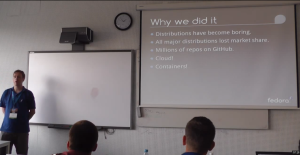Speaker: Christoph Wickert
Fedora.next needs some explanation for anyone who is familiar with the Fedora Linux distributions of the past. There has been considerable misunderstanding and FUD (not to mention a dash of conspiracy theory) since it was announced. Christoph offers in this hour to clarify both what Fedora.next is and why it is needed now.

Christoph asserts that “distros are boring”. He means that most people choose a distro they are comfortable with, not “which one is best”. The traditional delivery model has made assumptions that are no longer valid. Each distro release tried to meet everyone’s needs. Fedora.next represents a recognition that, with a common core, each of the Products can address the needs of a different audience well.
Wickert emphasizes that the environment into which new Fedora releases come is very different from what it was a decade ago. Virtualization was in its infancy, “Cloud Computing” didn’t exist. Container technology (at least in Linux) is still learning to walk today. The days when the only installation model was to boot an install DVD and run it have passed.
Fedora.now is really a change in the way the Fedora Community produces new output. Fedora 21 will be delivered as three “Products”. Each one is based off of a minimal core (there’s a working group for that too), but each has a specific mission and charter for its own audience.
By creating multiple Products Fedora can adapt to produce an operating system which is suited to new environments. The strong example is the Cloud product. It will be released as executable base images ready for use in virtualization environments. This would not have been allowed under the old model, which required the inclusion of OS installation tools such as Anaconda which are not needed in the final image. The Server product too has an innovation called the Cockpit which will lift the view of the sysadmin from that of OS configuration to managing the services that the server host provides.
Right now when you ask random people at Linux conferences “What is Fedora.next” most won’t know, and a few will have negative responses. The mission of Fedora advocates is to help people understand how the new structure will allow Fedora to address the needs of more people in the environment in which the user wants to work. They should avoid discussing how Fedora relates to Red Hat because it really doesn’t. Red Hat supports Fedora, and many employees are also contributors and members of the working groups but to paint them as “Red Hatters” vs “Contributors” does no one a service. Rather they should focus on what the Fedora Project is doing and how they are addressing the changing needs of the computing community at large.
There is still significant work to do to establish governance of the product working groups and to adapt the governance of the Fedora Project as a whole. Work continues and we’ll see with the release of Fedora 21 what has worked and what still needs work.
Christoph is a member of the Fedora Workstation working group.




